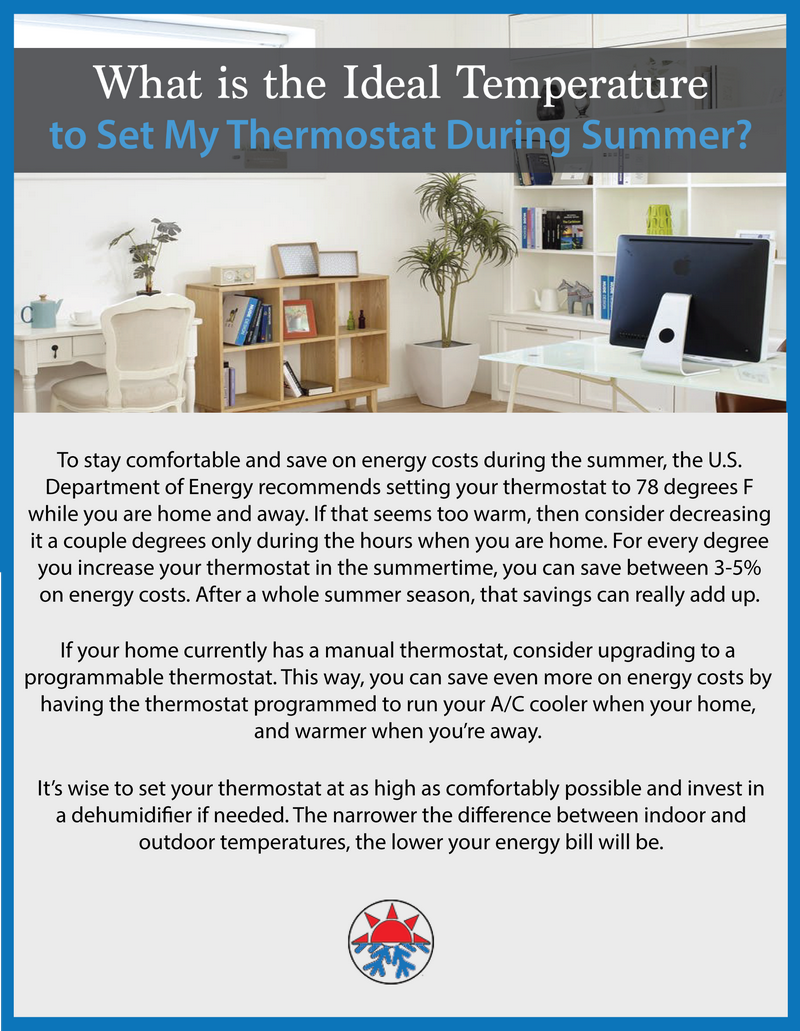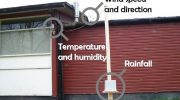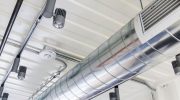
What is the Optimal Setting for Your Thermostat Temperature During the Summer Months?
Choosing the right temperature for your thermostat in the summer can be a difficult decision. With the hot weather outside, it’s important to find a balance between staying comfortable and saving energy. But what is the best temperature to set your thermostat to?
According to energy experts, the ideal temperature for your thermostat in the summer is 78 degrees Fahrenheit (25 degrees Celsius). This temperature is considered to be both comfortable and energy-efficient. However, it’s important to note that everyone has their own individual preferences, so you may want to experiment and find the temperature that works best for you.
Setting your thermostat to a higher temperature, such as 78 degrees, can help you save money on your energy bills. Each degree you raise your thermostat can save you up to 3% on your cooling costs. So, by setting your thermostat to 78 degrees instead of 72 degrees, you could save up to 18% on your cooling costs.
Of course, it’s also important to consider your personal comfort level when setting your thermostat. If you find that 78 degrees is too warm for you, you can adjust the temperature to a level that keeps you comfortable without using excessive energy. You can also consider using fans or adjusting your clothing to help you stay cool.
What Is the Best Temperature for Your Thermostat in the Summer?
When it comes to setting your thermostat in the summer, finding the best temperature for your home can help you stay comfortable and save energy. Here are some tips to help you decide:
- 78 degrees: This is the recommended temperature for most homes during the summer. It strikes a balance between energy efficiency and comfort. Keeping your thermostat set at 78 degrees can help you save money on your energy bills while still keeping your home cool.
- Adjust for personal preference: If 78 degrees feels too warm for your liking, you can adjust the temperature slightly lower. However, keep in mind that every degree you lower the thermostat increases your energy usage by about 3 percent. Finding a temperature that is comfortable for you while still being mindful of energy consumption is key.
- Consider using a programmable thermostat: A programmable thermostat allows you to set different temperatures for different times of the day. This can help you save energy by raising the temperature when you’re not at home or asleep, and lowering it when you’re active and need cooling.
- Use fans to supplement cooling: Fans can help circulate the air in your home and make it feel cooler, even if the thermostat is set at a higher temperature. Consider using ceiling fans or portable fans to help you stay comfortable while keeping the thermostat a little higher.
Remember, the best temperature for your thermostat in the summer may vary depending on factors such as humidity levels, insulation, and your personal comfort preferences. It’s important to find a balance that works for you and helps you stay comfortable while also conserving energy.
Benefits of Setting the Right Temperature
Setting the right temperature on your thermostat during the summer months can bring several benefits to your home and overall comfort. It is important to find a temperature that strikes a balance between keeping your home cool and minimizing energy usage.
Here are some of the benefits of setting the right temperature:
- Energy savings: Setting your thermostat to a slightly higher temperature can help reduce energy consumption and lower your electricity bills. By adjusting the temperature to a comfortable level instead of turning it to the lowest setting, you can save a significant amount of energy.
- Comfort: Finding the optimal temperature for your home ensures that you and your family remain comfortable throughout the summer. A setting that is too high may cause discomfort and sweatiness, while a setting that is too low can make your home feel excessively cold.
- Extended lifespan of your HVAC system: Constantly running your air conditioning system at a low temperature can put excessive strain on the system and decrease its lifespan. By setting the temperature at an appropriate level, you can help prolong the life of your HVAC system.
- Reduced environmental impact: Energy consumption contributes to the release of greenhouse gases and other pollutants into the environment. By setting your thermostat to a higher temperature, you can reduce your carbon footprint and help protect the environment.
- Consistent temperature: Setting a specific temperature helps maintain a consistent and even cooling throughout your home. This prevents hot spots and ensures that every room receives adequate cooling.
- Better sleep: Keeping the temperature at a comfortable level during the night can improve the quality of your sleep. A cooler environment helps your body maintain the ideal sleeping conditions, allowing you to rest and recharge.
In conclusion, setting the right temperature on your thermostat in the summer has several benefits. It not only saves energy and reduces costs but also improves comfort, extends the lifespan of your HVAC system, reduces environmental impact, and promotes better sleep. Experimenting with different temperature settings can help you find the optimal balance between cooling and energy efficiency for your home.
Factors to Consider when Setting Your Thermostat
When it comes to setting your thermostat during the summer months, there are several factors to consider. The temperature you set on your thermostat can affect your comfort, energy bills, and even the lifespan of your cooling system. Here are some important factors to keep in mind:
- Comfort: One of the main factors to consider when setting your thermostat is your comfort level. Everyone has different preferences when it comes to temperature, so it’s important to find a setting that keeps you comfortable without overcooling your home.
- Energy Efficiency: Setting your thermostat to a higher temperature can help save energy and reduce your cooling costs. The U.S. Department of Energy recommends setting your thermostat to 78°F (25.5°C) when you’re at home and raising it higher when you’re away.
- Humidity Control: An ideal thermostat setting not only controls the temperature but also the humidity level in your home. Higher humidity levels can make your home feel warmer, so it may be necessary to set your thermostat lower to counteract the effects of humidity.
- Sleeping Conditions: During the night, you may prefer a slightly cooler temperature for better sleep. Consider setting your thermostat a few degrees lower when you go to bed to create a more comfortable sleeping environment.
- Programmable Thermostat: If you have a programmable thermostat, take advantage of its features to schedule temperature changes throughout the day. This can help optimize your energy usage and ensure that your home is comfortable when you need it to be.
It’s important to find the right balance when setting your thermostat for the summer. Consider these factors and make adjustments as needed to create a comfortable and energy-efficient environment in your home.
How to Save Energy and Money
When it comes to setting your thermostat in the summer, finding the best temperature for energy efficiency is key to saving money on your utility bills. Here are some tips to help you save energy and money:
- Set your thermostat to a higher temperature: During the summer months, it is recommended to set your thermostat to a higher temperature when you are not at home. This will help to reduce the amount of energy your air conditioner uses and can save you money on your cooling costs.
- Use a programmable thermostat: Investing in a programmable thermostat allows you to set different temperature levels for different times of the day. For example, you can set the temperature to be higher when you are at work and lower when you are at home, ensuring that you are only cooling your home when it is necessary.
- Keep your home well insulated: Proper insulation can help to keep cool air inside your home and prevent air leakage. This means that your air conditioner won’t have to work as hard to cool your home, saving you energy and money.
- Use fans to circulate air: Ceiling fans and portable fans can help to circulate cool air throughout your home. By using fans in conjunction with your air conditioner, you can create a more comfortable environment without having to lower the temperature on your thermostat.
- Avoid using heat-generating appliances: Appliances such as ovens, stoves, and clothes dryers generate heat, which can make your home feel warmer. Try to limit the use of these appliances during the hottest parts of the day or consider using them in the evening when it is cooler outside.
By following these tips, you can not only save energy but also reduce your utility bills during the summer months. Setting your thermostat to a higher temperature, using a programmable thermostat, insulating your home, using fans to circulate air, and avoiding heat-generating appliances are all effective ways to stay cool while saving money.
Effects of the Wrong Temperature
Setting the thermostat to the wrong temperature during the summer can have various effects on both your comfort and energy usage. Here are some of the potential consequences:
- Discomfort: When the thermostat is set too high, the indoor temperature will be warmer than desired, leading to discomfort and decreased productivity. Similarly, setting it too low can result in a chilly environment, making it difficult to relax or sleep comfortably.
- Poor sleep quality: Incorrect thermostat settings can disrupt your sleep cycle. When the room is too warm or too cool, it can lead to difficulties falling asleep or staying asleep throughout the night, impacting your overall sleep quality.
- Inefficient energy usage: Setting the thermostat too low in an attempt to quickly cool down the house can lead to excessive energy consumption and higher utility bills. On the other hand, setting it too high can result in wasteful energy usage as the air conditioner will need to work harder to bring the temperature down.
- Increased humidity: Incorrect temperature settings can impact the humidity levels in your home. If the thermostat is set too high, it may not effectively remove moisture from the air, leading to a sticky and uncomfortable indoor environment.
- Uneven cooling: Setting the thermostat to the wrong temperature can result in uneven cooling throughout your home. Certain areas or rooms may feel excessively cold or warm, depending on the thermostat’s setting, causing discomfort and potential temperature imbalances.
- Shortened lifespan of HVAC systems: Constantly running the air conditioner at extreme temperatures can put strain on the system, potentially leading to premature wear and tear. This can result in increased repair costs and a shortened lifespan for your HVAC equipment.
- Environmental impact: Improper thermostat settings can contribute to energy waste, leading to increased carbon emissions and environmental impact. By setting the thermostat to the optimal temperature, you can help reduce your carbon footprint and promote sustainability.
By understanding the effects of the wrong temperature setting, you can make more informed decisions about the best temperature to set your thermostat to during the summer months.
Recommended Thermostat Settings
When it comes to setting your thermostat in the summer, finding the ideal temperature can help you stay comfortable while also saving energy. Here are some recommended thermostat settings to consider:
- Set the temperature between 75 and 78 degrees Fahrenheit: This range is generally recommended for the summer months, as it provides a balance between comfort and energy efficiency. However, you can adjust it based on your personal preferences.
- Use a programmable thermostat: Investing in a programmable thermostat allows you to automatically adjust the temperature based on your schedule. You can set it to be warmer during the day when no one is home and cooler when you return.
- Avoid setting the thermostat too low: While it may be tempting to set the thermostat at a very low temperature to cool your home faster, it won’t actually cool your home any faster. It will only result in excessive energy consumption.
- Consider using a fan: Using a fan can provide additional cooling and help circulate the air in your home. This can make you feel more comfortable without having to lower the thermostat temperature.
- Make use of natural ventilation: When the weather allows, opening windows and using natural ventilation can provide a refreshing breeze and reduce the need for air conditioning.
Remember, the best thermostat setting for your home may vary depending on factors such as climate, insulation, and personal preferences. It’s important to find the balance that works best for you in terms of comfort and energy savings.
Best Temperature for Sleeping
When it comes to getting a good night’s sleep, the temperature of your bedroom can play a key role. The ideal thermostat temperature for sleeping in the summer can vary depending on individual preferences, but there are some general guidelines that can help you find the best temperature for a restful night’s sleep.
Around 65 to 72 degrees Fahrenheit (18 to 22 degrees Celsius) is often considered the best temperature range for sleeping. This range is typically cool enough to promote the body’s natural cooling process and help you fall asleep faster. It also allows for the proper regulation of body temperature throughout the night, reducing the likelihood of waking up due to discomfort.
Keep in mind that personal preferences can vary, so it’s important to experiment with different temperature settings to find what works best for you. Some individuals may prefer slightly cooler or warmer temperatures for sleeping, so don’t be afraid to adjust the thermostat accordingly.
Here are some additional tips to optimize the temperature for sleeping:
- Use bedding materials that are breathable and moisture-wicking to promote airflow and prevent overheating.
- Avoid heavy blankets or comforters that can trap heat and make you feel uncomfortable.
- Consider using a fan or air conditioner to further control the temperature in your bedroom.
- Keep your bedroom dark and quiet to create a conducive environment for sleep.
- Adjust your thermostat to gradually decrease the temperature as you approach bedtime to signal your body that it’s time to sleep.
By creating a comfortable sleep environment with the right thermostat temperature, you can improve the quality of your sleep and wake up feeling refreshed and energized during the summer months.
Optimal Temperature for Productivity
When it comes to setting the thermostat during the summer, finding the optimal temperature for productivity is crucial. The temperature at which you set your thermostat can have a significant impact on your ability to concentrate and stay focused throughout the day.
Research has shown that the ideal temperature for productivity falls within a specific range. The American Society of Heating, Refrigerating, and Air-Conditioning Engineers (ASHRAE) recommends a temperature range of 73 to 79 degrees Fahrenheit (23 to 26 degrees Celsius) for optimal productivity. Within this range, individuals tend to perform better and experience fewer distractions.
Setting the temperature too high can lead to discomfort and sluggishness, while setting it too low can result in distraction and reduced cognitive function. By finding the right balance, you can create an environment that promotes productivity and efficiency.
It is also important to consider personal preferences and individual differences when setting the thermostat. Some individuals may prefer cooler temperatures, while others may feel more comfortable in warmer environments. Providing options for individuals to adjust the temperature within a reasonable range can help accommodate these differences and promote overall productivity.
Additionally, it is important to ensure proper insulation and ventilation in the workspace. Adequate insulation helps maintain a consistent temperature and prevents outside heat from affecting the indoor environment. Proper ventilation helps circulate fresh air and maintain air quality, which can further enhance productivity.
In conclusion, the optimal temperature for productivity in the summer falls within the range of 73 to 79 degrees Fahrenheit (23 to 26 degrees Celsius). By setting the thermostat within this range and considering personal preferences, providing options for adjustment, and ensuring proper insulation and ventilation, you can create an environment that promotes productivity and enhances overall performance.
Temperature for Home Security
Setting the thermostat at the right temperature is not just about comfort and energy efficiency; it can also significantly affect your home security.
It is important to find the best temperature to set your thermostat to in order to ensure the safety and security of your home. Here are some key points to consider:
- Consistent temperature: Maintaining a consistent temperature inside your house is crucial for home security. Extreme temperature fluctuations can damage your home’s infrastructure, such as causing cracks in walls or pipes to burst. By setting your thermostat to a suitable temperature, you can avoid potential risks and keep your home secure.
- Balance energy savings: While it is important to find a temperature that helps maintain security, it is also necessary to strike a balance with energy savings. Higher temperatures can lead to increased energy consumption, resulting in higher bills. Conversely, setting the temperature too low can also be impractical and uncomfortable. Finding the optimal temperature that meets both security and energy efficiency needs is key.
- Consider your climate: The ideal thermostat temperature for home security may vary depending on your climate. If you live in a hot climate, setting the temperature slightly higher may help reduce the risk of overheating and potential damage to appliances. In colder climates, a lower temperature may be necessary to prevent freezing pipes or other weather-related issues.
- Smart thermostat capabilities: Investing in a smart thermostat can enhance your home security and convenience. With features such as geofencing and remote access, you can easily monitor and adjust the temperature of your home no matter where you are. Smart thermostats can also learn your preferred settings and create personalized schedules to optimize security and energy efficiency.
In conclusion, finding the best temperature to set your thermostat to in the summer is crucial for maintaining home security. By considering factors like temperature consistency, energy savings, climate, and utilizing smart thermostat capabilities, you can create a comfortable and secure environment for your home.
Thermostat Settings for Pets
During the hot summer months, it is important to consider the well-being and comfort of our furry friends. Pets can be more sensitive to temperature changes than humans, which means that the thermostat settings in your home should take their needs into account. Here are some guidelines for setting your thermostat to keep your pets happy and healthy:
- Keep the temperature moderate: While it may be tempting to set the thermostat to a very low temperature during summer, it is important to find a balance. Aim for a temperature that feels comfortable for you, while also considering the needs of your pets. Generally, a range between 72°F and 78°F (22°C – 26°C) is recommended for most pets.
- Consider the breed: Different pets have different temperature requirements based on their breed. Some breeds, such as Siberian Huskies and Alaskan Malamutes, are better equipped to handle colder temperatures, while others, like Bulldogs and Pugs, are more sensitive to heat. Take into account the specific needs of your pet’s breed when setting the thermostat.
- Provide cooling options: In addition to setting the thermostat, it is important to provide your pets with other cooling options. Make sure they have access to fresh water at all times and consider using fans, cooling mats, or air conditioning in the areas where they spend the most time.
- Observe your pet: Pay attention to your pet’s behavior and body language to determine if they are comfortable. Signs of discomfort in pets can include excessive panting, restlessness, seeking out cooler areas of the house, or reluctance to go outside. Adjust the thermostat accordingly if you notice any of these signs.
- Consult your veterinarian: If you have specific concerns about your pet’s ability to tolerate heat or if you are unsure about the ideal thermostat settings, it is always best to consult with your veterinarian. They can provide personalized advice based on your pet’s health, age, and breed.
By considering their needs and making necessary adjustments, you can ensure that your pets stay comfortable and safe during the hot summer months. Remember to always prioritize their well-being when setting the thermostat in your home.
Impact of Outdoor Temperature
The outdoor temperature during the summer has a significant impact on the temperature you should set on your thermostat. It affects your comfort level, energy consumption, and ultimately, your electricity bill.
In order to determine the best temperature to set your thermostat to in the summer, it is important to understand the impact of the outdoor temperature. Here are some key factors to consider:
- Comfort: The outdoor temperature directly affects your indoor comfort. A higher outdoor temperature will require a lower thermostat setting to achieve a comfortable indoor temperature. On the other hand, a lower outdoor temperature will allow for a higher thermostat setting without sacrificing comfort.
- Energy consumption: The lower you set your thermostat, the less energy you will consume. However, setting the thermostat too low can result in unnecessary energy consumption. It is important to find a balance between comfort and energy efficiency.
- Electricity bill: The outdoor temperature can also impact your electricity bill. Setting your thermostat too low in response to high outdoor temperature can result in higher energy consumption and ultimately, a higher electricity bill. Finding the optimal thermostat setting based on the outdoor temperature can help save energy and reduce your bill.
It is recommended to use a programmable thermostat that allows you to set different temperatures for different times of the day. This way, you can adjust the thermostat setting based on the outdoor temperature and your daily schedule.
| 90°F and above | 78°F |
| 80°F to 89°F | 75°F to 78°F |
| 70°F to 79°F | 72°F to 75°F |
| 69°F and below | 68°F to 72°F |
Using the above table as a reference, you can adjust your thermostat setting based on the outdoor temperature to achieve optimal comfort and energy efficiency. This will help you stay cool during the summer while also saving on your electricity bill.
Health Benefits of a Proper Thermostat Setting
A proper thermostat setting can have numerous health benefits for individuals and families. By setting the thermostat to the best temperature, you can improve your overall well-being and comfort in the summer.
- Improved Sleep: Setting the thermostat to a cooler temperature can help improve sleep quality. Research suggests that the ideal room temperature for sleep is between 60 to 67 degrees Fahrenheit (15 to 19 degrees Celsius). A cool bedroom environment promotes the release of melatonin, a hormone that regulates sleep, and helps you fall asleep faster and enjoy a more restful sleep.
- Reduced Allergies: Proper temperature settings can also help reduce allergies. Keeping the thermostat at a lower temperature helps decrease the humidity in the air, which discourages the growth of mold and dust mites. These common allergens thrive in humid environments, so controlling the temperature can help alleviate symptoms such as sneezing, coughing, and congestion.
- Increased Energy and Productivity: A comfortable temperature in your living or working space can boost your energy levels and productivity. When the temperature is too hot, it can make you feel lethargic and decrease your motivation to work or engage in physical activity. By setting the thermostat to a cool and comfortable temperature, you can feel more alert, focused, and energized.
- Prevention of Heat-Related Illnesses: Setting the thermostat to an appropriate temperature can help prevent heat-related illnesses and heat exhaustion. During the summer, excessive heat can lead to dehydration, heat cramps, and even heat stroke. By keeping your living space cool, you can lower the risk of these conditions and ensure your body can regulate its temperature effectively.
- Improved Air Quality: Proper thermostat settings can also contribute to improved indoor air quality. When the temperature is set to a comfortable level, your HVAC system can function optimally, ensuring proper air circulation and filtration. This helps remove particles, pollutants, and allergens from the air, improving the overall air quality and reducing respiratory issues.
By setting your thermostat to the best temperature, you can enjoy these health benefits and create a comfortable environment for yourself and your family during the summer.
Best Temperature for Air Quality
When setting the thermostat in the summer, it’s not only important to consider your comfort but also the air quality in your home. The temperature you choose can significantly impact the air quality, so it’s crucial to find the right balance.
During the summer, it’s generally recommended to set your thermostat to a temperature between 72°F (22°C) and 78°F (25°C) for optimal air quality. This range allows for a comfortable indoor environment while also preventing the air from becoming too humid or stagnant.
Humidity plays a significant role in air quality, as excessive moisture in the air can promote the growth of mold and mildew. By setting your thermostat within this recommended range, you can help control humidity levels and reduce the risk of mold or mildew formation.
In addition to humidity, a temperature within this range helps maintain good air circulation. Stagnant air can lead to a buildup of pollutants, such as dust, pet dander, and allergens, which can cause respiratory irritation or worsen allergies. By keeping the air moving at a comfortable temperature, you can promote better air quality in your home.
It’s important to note that individual preferences and specific circumstances may require slight adjustments to this temperature range. For example, if someone in your household has respiratory issues or allergies, you may want to set the thermostat closer to the lower end of the range for better air quality.
In conclusion, the best temperature for air quality in the summer is typically between 72°F (22°C) and 78°F (25°C). This range helps control humidity levels and promotes better air circulation, reducing the risk of mold, mildew, and pollutant buildup. Finding the right balance will not only improve the air you breathe but also ensure a comfortable indoor environment during the hot summer months.
Ideal Thermostat Setting for Allergies
Allergies can be a major problem during the summer months, and finding ways to minimize symptoms is key to staying comfortable. One way to help reduce allergies is by setting your thermostat to the ideal temperature.
Experts recommend keeping your home at a consistent temperature to help reduce allergens. The best temperature to set your thermostat to in the summer is around 72°F (22°C). This temperature is cool enough to provide relief from the heat, but not too cold to trigger allergies.
In addition to setting the temperature, it is also important to make sure your home is properly ventilated. This can help prevent the buildup of allergens such as dust and pollen. Opening windows and using fans can help circulate fresh air and reduce allergens in your home.
Another important factor to consider is humidity. High humidity levels can promote the growth of mold and mildew, which can trigger allergies. Keeping your home’s humidity levels below 50% can help prevent these allergens from thriving.
It is also important to regularly clean and replace your air filters. This will help remove allergens from the air and improve air quality in your home. Using high-quality air filters can help capture even the tiniest particles, including pet dander and dust mites.
By maintaining the ideal thermostat setting and taking steps to reduce allergens in your home, you can enjoy a more comfortable summer and minimize the impact of allergies.
Energy-Saving Tips for Summer
When it comes to keeping your home cool during the summer months, finding the best temperature to set your thermostat can make a big difference in your energy consumption and utility bills. Here are some energy-saving tips to help you beat the heat while also saving money:
- Set your thermostat to the highest comfortable temperature: Every degree you raise your thermostat can save you up to 3% on cooling costs. Consider setting it to around 78°F (25.5°C) when you’re at home and slightly higher when you’re away.
- Use a programmable thermostat: A programmable thermostat allows you to set different temperatures for different times of the day, so you can automatically adjust the temperature when you’re not at home or when you’re sleeping.
- Utilize natural ventilation: Take advantage of cooler evening or early morning temperatures by opening windows and letting in fresh air. Use fans to circulate the air and create a cooling breeze.
- Keep blinds and curtains closed: Blocking out sunlight can help keep your home cooler and reduce the need for air conditioning. Consider using light-colored or reflective window coverings to minimize heat gain.
- Insulate your home: Proper insulation can help keep cool air inside and prevent hot air from entering. Insulating your attic, walls, and floors can significantly reduce your cooling costs.
- Avoid using heat-generating appliances: During the hottest parts of the day, try to limit the use of appliances that generate heat, such as ovens, dryers, and dishwashers. Instead, opt for grilling outdoors or using smaller appliances.
- Maintain your cooling system: Regularly clean and replace filters in your air conditioning system to ensure it operates efficiently. Schedule annual maintenance to keep it running smoothly.
- Create shade around your home: Planting trees or installing awnings and shade screens can help reduce the amount of direct sunlight that reaches your home, keeping it cooler naturally.
By implementing these energy-saving tips, you can stay comfortable during the summer while also reducing your environmental impact and saving money on your energy bills.
Programmable and Smart Thermostat Features
A thermostat is an essential tool for maintaining the optimal temperature in your home during the summer months. With the advancement of technology, there are now programmable and smart thermostats available that offer a variety of features to help you set the best temperature for your comfort and energy efficiency.
1. Programmable Thermostats
Programmable thermostats allow you to set different temperatures for different times of the day. This feature is especially useful when you are away from home during the summer. You can program the thermostat to adjust the temperature higher when you are not at home and lower it just before you return. This way, you can save energy and ensure a comfortable temperature when you arrive.
2. Smart Thermostats
Smart thermostats take programmable thermostats to the next level. They have Wi-Fi connectivity, allowing you to control the thermostat remotely through a smartphone app. This means you can adjust the temperature even when you are not at home. For example, if you are coming home earlier than expected, you can use the app to lower the temperature and have a cool home waiting for you.
3. Learning Technology
Some smart thermostats have learning technology that adapts to your schedule and temperature preferences. This means that over time, the thermostat will learn when you are typically at home and what temperatures you prefer. It will then automatically adjust the temperature accordingly, providing optimal comfort and energy efficiency without any manual input.
4. Energy Usage Reports
Many programmable and smart thermostats provide energy usage reports that show you how much energy you are using and how it is being distributed throughout the day. This information can help you make informed decisions about your energy consumption and adjust your thermostat settings to save more energy and reduce your utility bills.
5. Compatibility with Other Smart Home Devices
Smart thermostats often offer compatibility with other smart home devices, such as smart lights and smart locks. This allows you to integrate all your devices and create automated routines. For example, you can program your thermostat to adjust the temperature when you arm or disarm your security system, making your home more energy efficient and secure.
6. Vacation Mode
Both programmable and smart thermostats usually have a vacation mode feature. This feature allows you to set a higher temperature when you are away for an extended period, such as a summer vacation. By raising the temperature, you can save energy and reduce your utility bills while ensuring that your home doesn’t get too hot and humid.
Conclusion
Programmable and smart thermostats offer a range of features that can help you set the best temperature for your home during the summer. From programmable schedules to remote control and learning technology, these thermostats provide convenience, energy efficiency, and optimal comfort. Consider upgrading your thermostat to take advantage of these features and enjoy a cool and comfortable home all summer long.
How to Find Your Comfort Zone
When it comes to setting the temperature on your thermostat during the summer months, finding your comfort zone is essential. Here are some tips to help you determine the best temperature for you:
- Start with a baseline: Begin by setting your thermostat to a temperature that you find comfortable.
- Experiment: Gradually adjust the temperature up or down to see how it affects your comfort level. Take note of any changes in your sleep quality, mood, or overall well-being.
- Consider your lifestyle: Think about your daily activities and how temperature affects them. If you’re more active and tend to sweat, you may prefer a slightly cooler temperature. On the other hand, if you spend a lot of time sedentary, a warmer setting might be more suitable.
- Pay attention to humidity: High humidity levels can make it feel hotter than it actually is. Consider using a dehumidifier to reduce humidity and improve comfort.
- Take advantage of programmable features: If your thermostat has programmable settings, take advantage of them. Set different temperatures for different times of the day based on your preferences and daily routines.
Remember, everyone’s comfort zone is different. What works for one person might not work for another. It’s important to find the temperature that allows you to feel comfortable and enjoy your summer months to the fullest.
Q&A:
What is the ideal temperature to set the thermostat to in the summer?
The ideal temperature to set the thermostat to in the summer is around 78 degrees Fahrenheit (25 degrees Celsius). This temperature balance helps to save energy and maintain a comfortable indoor environment.
Is it better to set the thermostat to a higher temperature and use fans to stay cool?
Yes, it is better to set the thermostat to a slightly higher temperature, such as 78 degrees Fahrenheit (25 degrees Celsius), and use fans to stay cool. This allows for energy savings while still maintaining a comfortable environment.
Can I set the thermostat to a lower temperature to cool my house faster?
No, setting the thermostat to a lower temperature will not cool your house faster. The air conditioning system works at a constant rate, and lowering the temperature will only make it work longer to reach the desired temperature.
What are some other tips for keeping the house cool during the summer?
Some other tips for keeping the house cool during the summer include closing blinds and curtains during the hottest parts of the day, using ceiling fans to circulate air, and avoiding heat-generating activities like using the oven. Additionally, proper insulation and sealing any air leaks can also help to keep the house cool.








